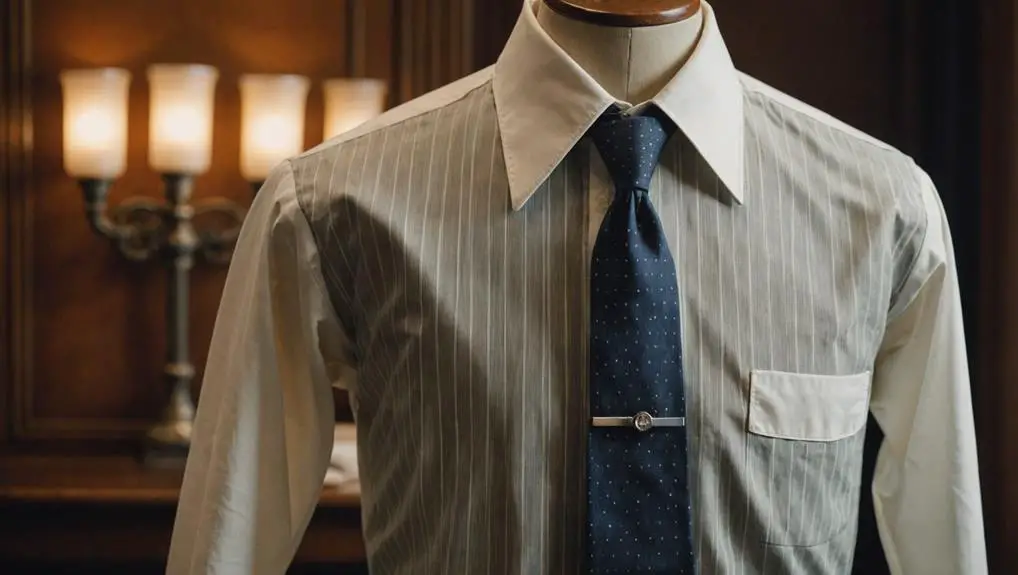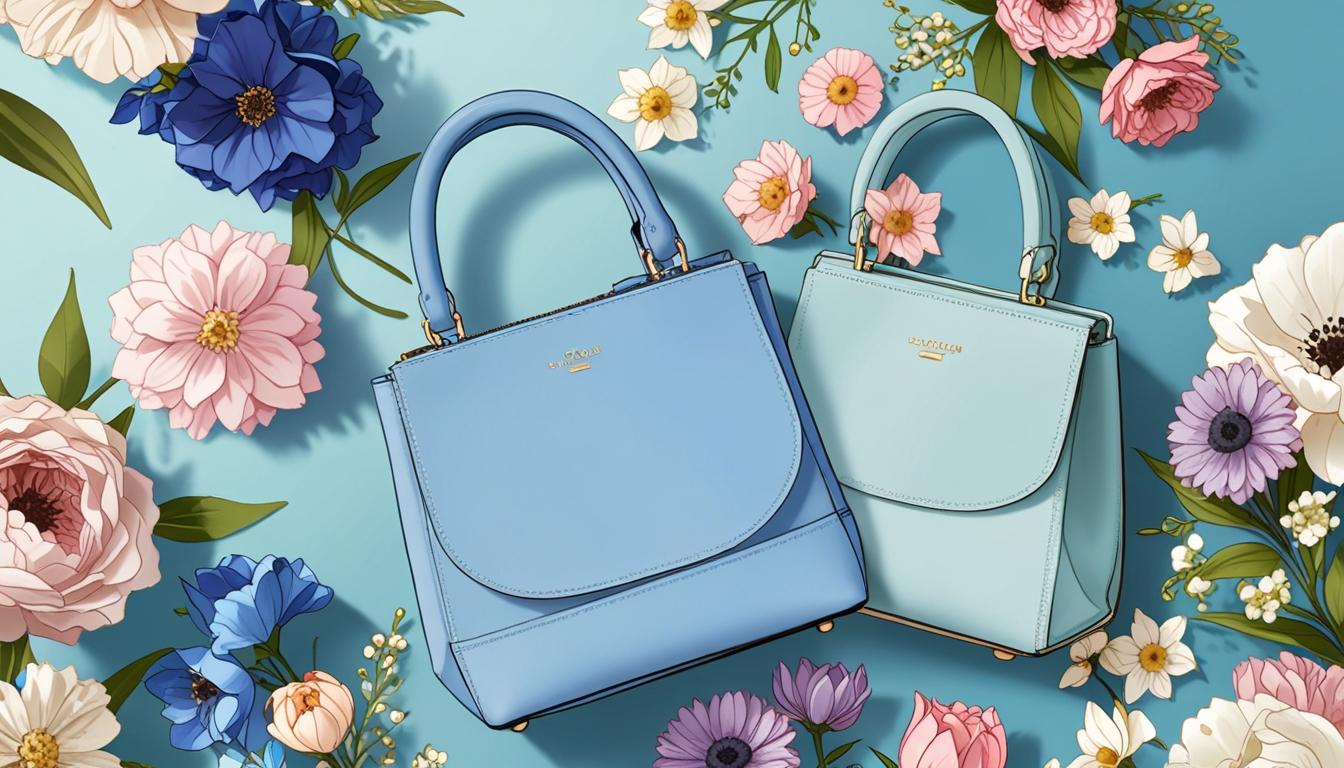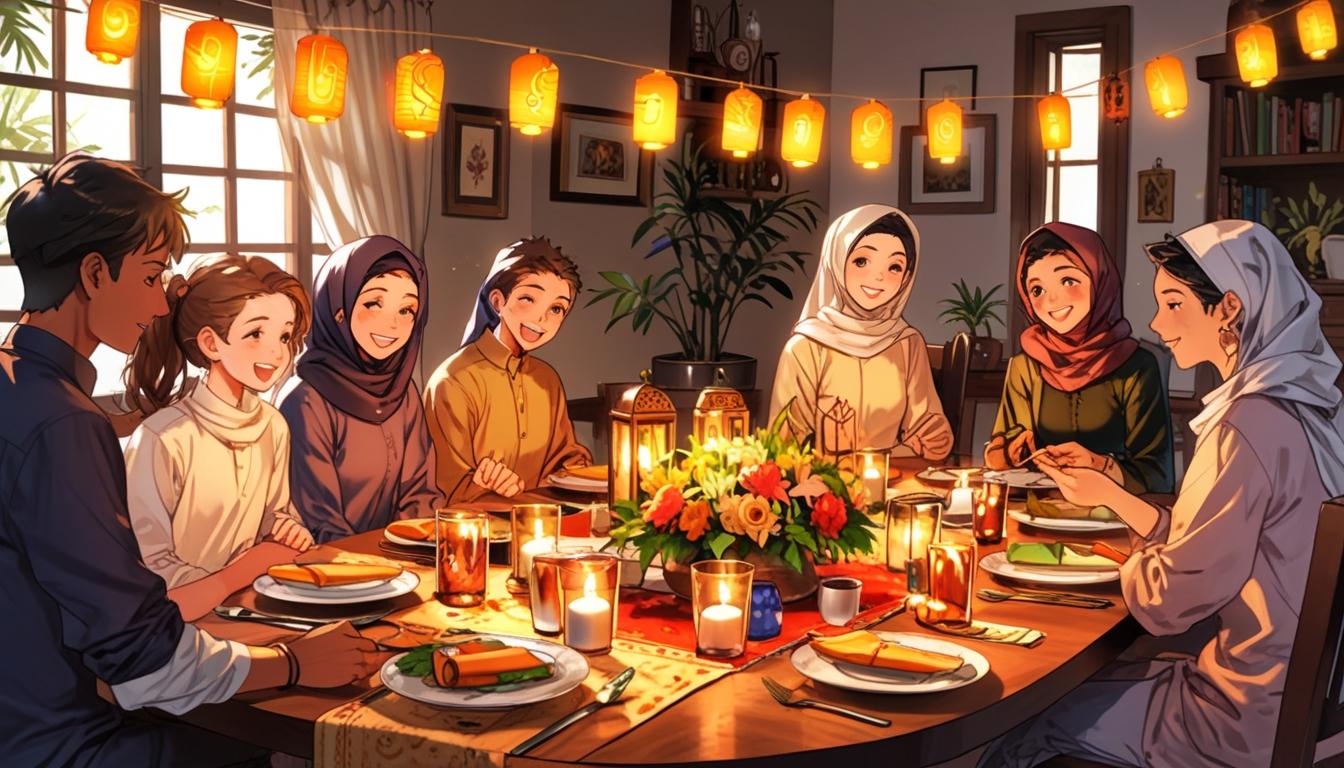Men's dress shirts in the 1920s reflect a fascinating interplay of style and societal change. You'd notice a variety of options, from sophisticated tuxedo shirts with detachable collars to relaxed club collar designs that exude charm. The emergence of softer, attached collars signaled a shift towards comfort, while pointed and wing tip collars catered to formal events. Brands like Jack Martin and Van Heusen led the way, offering a spectrum that included everything from classic French cuffs to modern casual shirts. The decade's cultural influences shaped these trends, suggesting there's much more to explore in this stylish era.
Types of Dress Shirts
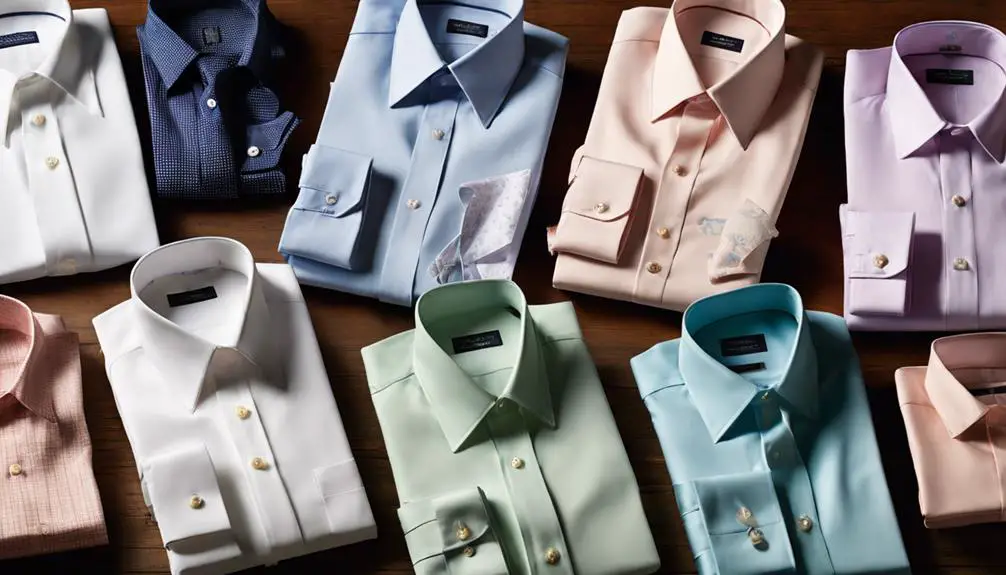
In the 1920s, men's dress shirts were more than just clothing; they were a reflection of evolving social norms and personal style. The decade introduced a variety of dress shirts that catered to both formal and casual occasions, making them crucial in every man's wardrobe. Among the most notable styles were the tuxedo shirts, often designed with elegant pleats and detachable collars, allowing for versatility depending on the event.
Long sleeve dress shirts became the go-to choice for formal settings, frequently paired with French cuffs and cufflinks that added a touch of sophistication. This preference highlighted a shift toward a more polished appearance, as men sought to impress in social gatherings.
On the other hand, club collar shirts emerged as a fashionable staple, featuring a rounded collar that exuded charm and relaxed elegance. As comfort gained importance, casual stylish shirts began to enter everyday wear, merging functionality with contemporary flair.
Button-up shirts remained essential, offering the flexibility to dress up or down as the occasion warranted. This diverse range of men's dress shirts not only showcased individual style but also mirrored the dynamic cultural landscape of the 1920s.
Popular Styles and Brands
The 1920s saw an exciting array of popular styles and brands that defined men's dress shirts, reflecting the decade's dynamic spirit. You'd find a mix of formal and casual options, with brands like Jack Martin leading the way in offering club collar and dress shirts. The navy blue narrow stripe penny collar shirts became a go-to for formal events and weddings, while Oxford pin collar shirts added a touch of sophistication to your wardrobe. Vintage clothing labels from this era often showcased unique designs and craftsmanship, offering insight into the fashion trends of the time, including vintage clothing identification. Historical Emporium specialized in Edwardian club collar shirts, allowing you to embrace the trends of the era. If you sought something more upscale, Alimens & Gentle provided French cuff regular fit shirts, perfect for those mens formal occasions that required an elevated look. Meanwhile, the rise of casual stylish shirts gained traction, integrating seamlessly into everyday wear, a shift echoed in shows like "Downton Abbey" and "Peaky Blinders." These influences shaped the sartorial landscape, making it clear that fashion was evolving. By blending traditional elements with modern flair, the 1920s set the stage for the diverse shirt styles we see today, showcasing a unique balance between elegance and ease.
Collar Variations and Trends
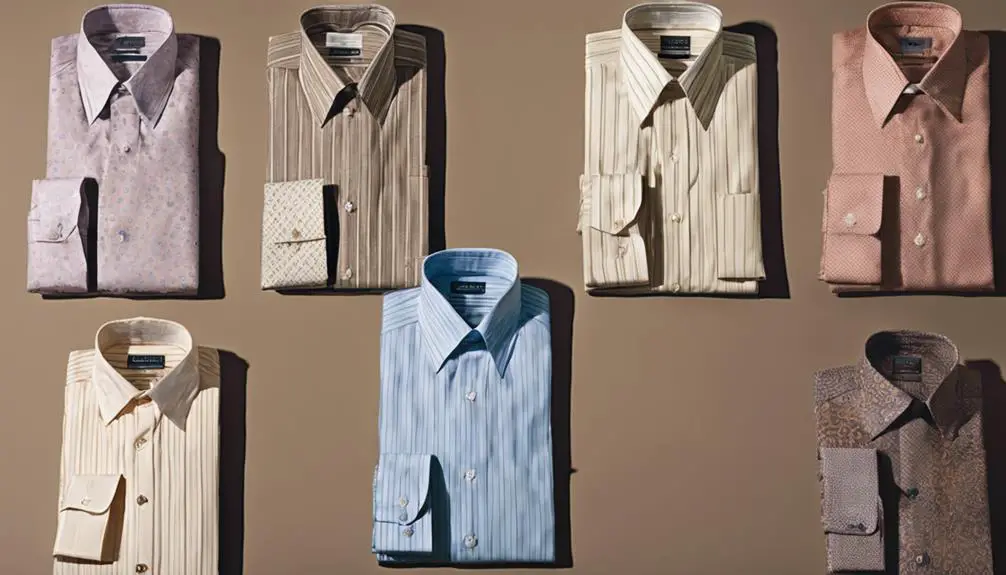
Shifts in fashion during the 1920s brought about a remarkable variety of collar styles that played a significant role in defining men's dress shirts. The era's preferences reflected a blend of formality and evolving social norms. You'd find pointed, rounded, and wing tip collars, each suited for different occasions and showcasing your personal style.
Detachable collars became a fashionable accessory, allowing you to customize your look effortlessly. Available in stiff, semi-stiff, and soft varieties, these collars let you adapt your attire to fit the event, from formal gatherings to casual outings. By the late 1920s, soft collars gained traction, making them a popular choice for everyday wear.
Here's a quick overview of the collar variations:
| Collar Type | Usage |
|---|---|
| Pointed Collar | Versatile for various settings |
| Wing Tip Collar | Formal evening attire |
| Soft Collar | Casual and everyday wear |
As the decade progressed, the trend shifted towards softer, attached collars, mirroring broader societal changes towards comfort in vintage men's fashion. Understanding these collar variations helps you appreciate the dynamic nature of men's dress shirts in the 1920s.
Pricing and Availability
Steering the world of men's dress shirts in the 1920s reveals a fascinating landscape of pricing and availability that catered to a range of budgets and tastes. You'd find that the prices for men's shirts varied greatly—starting around $24.00 for casual styles and going as high as $248.00 for premium Henley shirts. This diversity in pricing allowed consumers to select shirts that matched their personal style and financial situation.
Here's a quick breakdown of what you might encounter:
- Casual shirts typically ranged from $41.53 to $119.00, reflecting varied quality.
- Specialty items, including historical styles, could cost around $71.00.
- Notable brands like Van Heusen and Wilson Brothers provided a wide selection.
- Vintage options were available for auction, starting from as low as $28.57.
- Discounts and sales often played a significant role, offering consumers the chance to snag deals.
This intricate pricing structure not only showcased the evolving fashion landscape but also highlighted how men's shirts, from casual to premium offerings, became essential components of a man's wardrobe in the 1920s.
Cultural Influences on Fashion
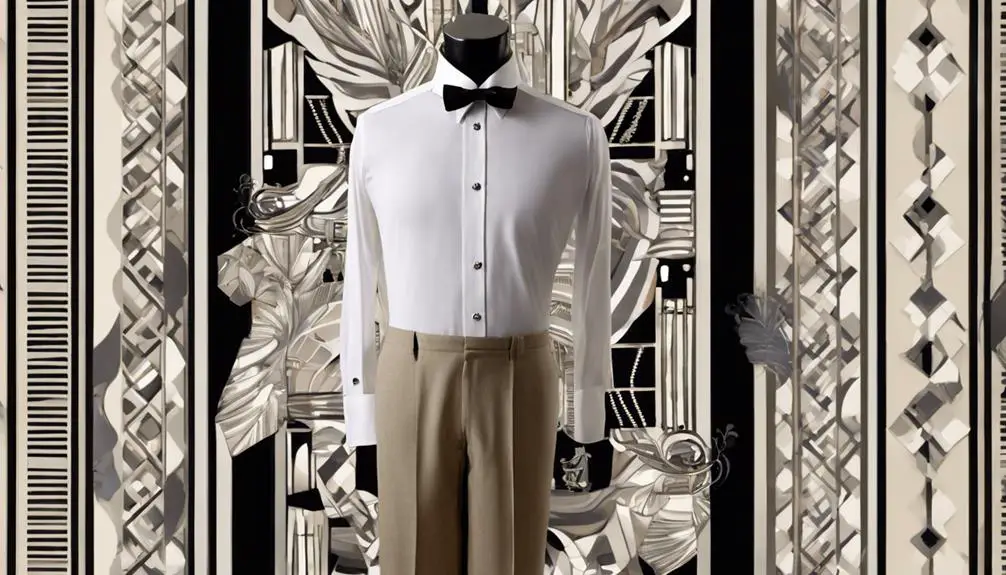
Cultural influences in the 1920s reshaped men's fashion, creating a vibrant tapestry that reflected the era's dynamic social changes. Following World War I, a bold expression emerged, driven by increased consumerism and a desire for comfort. The rise of nightlife and Prohibition popularized styles associated with speakeasies, leading to relaxed fits and vibrant patterns in shirts. The gangster culture, epitomized by shows like *Peaky Blinders*, introduced three-piece suits and accessories that became emblematic of this transformative period.
The shift from stiff, formal wear to softer fabrics signaled broader societal changes, embracing ease and comfort in clothing. Collar shirts, particularly with Art Deco influences, showcased geometric patterns and bright colors that captured the exuberance of the Jazz Age. These cultural shifts allowed for seasonal fashion cycles, enabling experimentation and variety in men's dress shirts.
As you explore the styles of this decade, it's clear that the interplay of cultural elements—music, nightlife, and societal changes—significantly impacted how men dressed, making the 1920s a landmark era for fashion. The blend of boldness and comfort redefined masculinity and set the stage for future trends.
Evolution of Shirt Design
Emerging from the dynamic landscape of the 1920s, the evolution of shirt design reflected a significant transformation in men's fashion. Early in the decade, narrow neckbands with buttonholes at the front and back set a formal tone, emphasizing the importance of appearances. Detachable collars became a versatile option in formal wear, allowing men to switch styles easily.
Consider these key developments in shirt design during this period:
- Detachable collars: Available in stiff, semi-stiff, and soft varieties, they catered to varying tastes.
- Variety of styles: Pointed, rounded, and wing-style collars gained popularity, showcasing personalized expression.
- Shift to softness: By the mid-1920s, there was a noticeable trend toward softer, attached collars, reflecting a desire for comfort.
- Byron collar: This style emerged as a popular choice, draping elegantly across jacket lapels for relaxed formal wear.
- Cultural tensions: The change from stiff to soft collars mirrored the era's cultural shifts, with comfort increasingly overshadowing traditional British fashion ideals.
This evolution in shirt design illustrates how fashion not only adapts to style but also to societal changes, redefining masculinity in the process.
Frequently Asked Questions
What Kind of Shirts Did Men Wear in the 1920s?
In the 1920s, you'd find men wearing a variety of shirts featuring club collars, French cuffs, and button-up designs. These styles reflected a shift towards comfort while maintaining elegance, showcasing the era's evolving fashion sensibilities.
How to Dress a 1920S Male?
To dress like a 1920s man, you'll want a tailored suit with a slim fit, bold patterns, a matching waistcoat, and stylish accessories like a fedora, pocket square, and a necktie for that authentic flair.
What Did Upper Class Men Wear in the 1920s?
Upper class men in the 1920s donned tailored suits, often paired with luxurious fabrics, accessorized with elegant ties and cufflinks. Their attire reflected sophistication and a keen attention to social status, emphasizing both style and comfort.
Did Men Wear Double-Breasted Suits in the 1920s?
Yes, men did wear double-breasted suits in the 1920s. You'd notice their broad, elegant tailoring and wide lapels, making them a popular choice for both formal and business occasions, reflecting sophistication and style.
